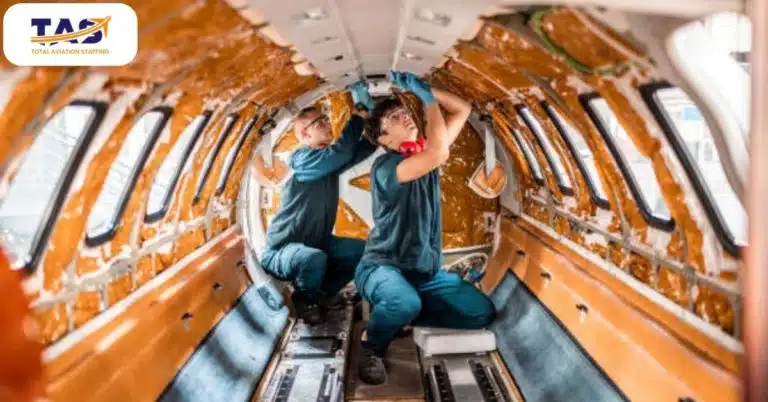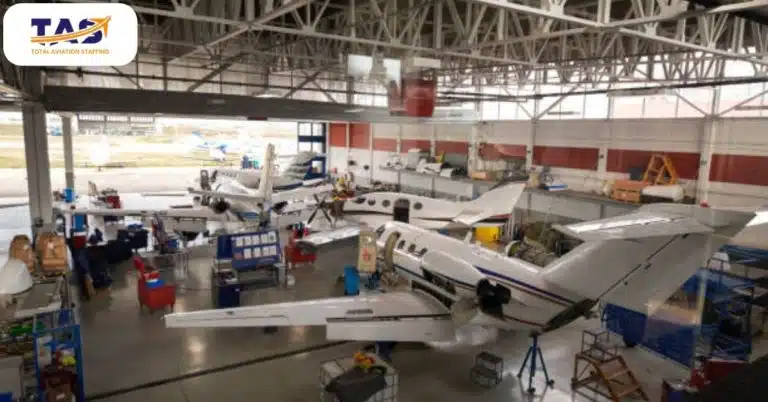What Does an Aircraft Structures Technician Do?

Buckle up and get ready to take off into the exciting world of aircraft maintenance! Have you ever wondered who keeps those flying machines in the sky? Aircraft Structures Technicians play a crucial role in ensuring the safety and integrity of aircraft.
In this blog, we will explore what an Aircraft Structures Technician does and the vital skills required to maintain aircraft airworthiness. So, let’s dive into the world of aircraft maintenance and explore this exciting career path!
Examining Aircraft Structures: A Day in the Life of an Aircraft Structures Technician
A day in the Life of an Aircraft Structures Technician involves repairing and maintaining various aircraft structures, such as sheet metal, flight control surfaces, fuel cells, and windshields. The technician reads and interprets engineering blueprints and specifications to determine layouts and sequences of operations, and operates a variety of tools and equipment, including gas-based Arc welding equipment, brazing equipment, and riveting tools.
They remove damaged parts, cut, and trim sheet metal to fit within tolerances, and ensure compliance with FAA maintenance bulletins. The technician must exercise good judgment in a team environment, perform unsupervised line maintenance functions, and have excellent communication and problem-solving skills.
The job requires working nights, weekends, and holidays, and being able to lift and move heavy items. Overall, it’s a challenging but rewarding career path for those passionate about aviation and attention to detail.

Keeping Planes Safe: The Role of an Aircraft Structures Technician in Maintaining Aircraft Integrity
The role of an Aircraft Structures Technician is vital in ensuring the safety and integrity of aircraft. Their primary responsibility is to maintain and repair various structural components of the aircraft, such as sheet metal, fuel cells, and flight control surfaces.
Here are some key ways they keep planes safe:
Inspect aircraft structures and components for damage or wear.
Repair or replace damaged or worn parts, such as sheet metal, flight control surfaces, and fuel tanks.
Use specialized tools and techniques to ensure precise fit and compliance with FAA maintenance bulletins.
Follow engineering blueprints and specifications to maintain the proper layout and sequence of operations.
Document all maintenance work and ensure compliance with company and manufacturer manuals.
Work in a team environment and exercise good judgment to ensure the safety of the aircraft and passengers.
Aircraft Structures Technicians soar above the rest when it comes to ensuring the safety of our flying machines. With their unwavering dedication and meticulous attention to detail, they are the guardians of aircraft integrity, always ready to tackle structural challenges head-on. From riveting to repairs, they masterfully navigate the intricate web of metal and composite materials, leaving no flaw unattended. These skilled professionals take pride in their work, leaving no room for error and maintaining the highest standards of safety in the aviation industry.

From Inspection to Repair: The Diverse Skills Required of an Aircraft Structures Technician
Aircraft Structures Technicians require a diverse set of skills, ranging from technical expertise to problem-solving and communication skills.
Here are some of the skills they need to have:
Knowledge of aircraft structures and components, including sheet metal and composite materials.
Ability to interpret engineering blueprints and schematics.
Proficiency in using specialized tools and equipment, such as welding and riveting tools.
Attention to detail and the ability to identify and diagnose structural issues.
Excellent problem-solving and critical-thinking skills.
Good communication skills to work effectively with team members and other departments.
Physical dexterity and the ability to lift heavy objects and work in confined spaces.
Familiarity with FAA regulations and compliance requirements.
In a world where aircraft maintenance is no laughing matter, Aircraft Structures Technicians are the true masters of their craft. With the power of on-the-job training, apprenticeships, and continuing education programs, they shape their skills into a force to be reckoned with. And if that’s not impressive enough, they even have the option to earn professional certifications, proving they’re the superheroes of aircraft maintenance.
So, if you’re looking for a career that lets you rise above the clouds while keeping your feet firmly on the ground, join the ranks of these skilled technicians. With dedication and an insatiable thirst for knowledge, you can soar to new heights and enjoy a fulfilling journey in the aviation industry. Get ready to strut your stuff, because the sky’s the limit for Aircraft Structures Technicians!

How to Become an Aircraft Structures Technician: Education, Training, and Certification Requirements
Becoming an aircraft structures technician requires a combination of education, training, and certification. As an essential members of the aviation maintenance team, aircraft structures technicians are responsible for ensuring the integrity and safety of aircraft structures.
Here are the key points to becoming an Aircraft Structures Technician:
Education: High school diploma or GED required. Some employers prefer candidates with post-secondary education in aviation maintenance technology or a related field.
Training: Candidates must complete an FAA-approved aviation maintenance technician training program or gain equivalent on-the-job training.
Certification: Candidates must hold a valid FAA Airframe and Powerplant (A&P) Certificate, which requires passing a series of written, oral, and practical exams. Continuing education is required to maintain certification.
Other skills: Knowledge of technical manuals, the ability to read and interpret engineering drawings and schematics, and proficiency in using various hand and power tools are essential skills for aircraft structures technicians.
Experience: Prior experience in sheet metal and fabrication is preferred, but not required.
Advancement: With experience and additional certifications, Aircraft Structures Technicians can advance to supervisory or management positions.
Becoming an aircraft structures technician is like unlocking a secret code to success. By cracking the books, mastering the training, and earning those coveted certifications, you’ll become the crème de la crème of sought-after professionals.
So, if you’re ready to take flight on a thrilling career path, don’t miss your chance to join the elite ranks of aircraft structures technicians. Embrace the challenge, soar through the skies of education, and watch your dreams of becoming an aviation superstar become a reality.

The Future of Aircraft Structures Technology: Challenges and Opportunities for Aircraft Structures Technicians.
The aircraft industry is constantly evolving, and aircraft structure technology is no exception. As new materials and technologies emerge, Aircraft Structures Technicians face both challenges and opportunities to adapt and grow.
Future of aircraft structures technology:
Advancements in materials technology
Increased use of 3D printing for aircraft parts
Integration of artificial intelligence and machine learning for maintenance and inspections
Continued development of unmanned aerial vehicles (UAVs) and electric aircraft
Challenges for Aircraft Structures Technicians:
Need to continually update skills to keep up with new technology
Safety and regulatory requirements
Increased competition for jobs
Opportunities for Aircraft Structures Technicians:
Growing demand for air travel and aircraft maintenance
Advancements in technology create new job opportunities
Potential for higher salaries with specialized skills and experience
In the ever-changing skies of the aircraft industry, Aircraft Structures Technicians are the bold pioneers ready to tackle any challenge that comes their way. With an unwavering commitment to continuous learning and growth, they transform obstacles into opportunities, soaring above the rest. Armed with their expertise and determination, these technicians navigate the dynamic field with finesse, leaving a trail of excellence behind them. Buckle up and join the ranks of these fearless professionals, because in the world of Aircraft Structures Technicians, the sky’s the limit!

The Bottom Line
An Aircraft Structures Technician is a skilled professional responsible for keeping airplanes in top-notch condition. They perform a wide range of tasks, from routine inspections to complex repairs, ensuring that every aircraft is safe and airworthy. With the growing demand for air travel, the job outlook for Aircraft Structures Technicians is promising, and those who pursue this career can look forward to exciting challenges and opportunities in the future. So, if you have a passion for aviation and a knack for problem-solving, this might be the perfect career for you!
Ready to take off in your aviation career? Total Aviation Staffing can help you find the right job and take your skills to new heights! With connections to top aerospace and aviation companies across the U.S., we’ll help you achieve your goals and secure your dream job as an Aircraft Structures Technician. Don’t wait any longer, contact us now to build your future in the aviation industry! Click on the link to browse through aviation job openings and take the first step toward a fulfilling career.
